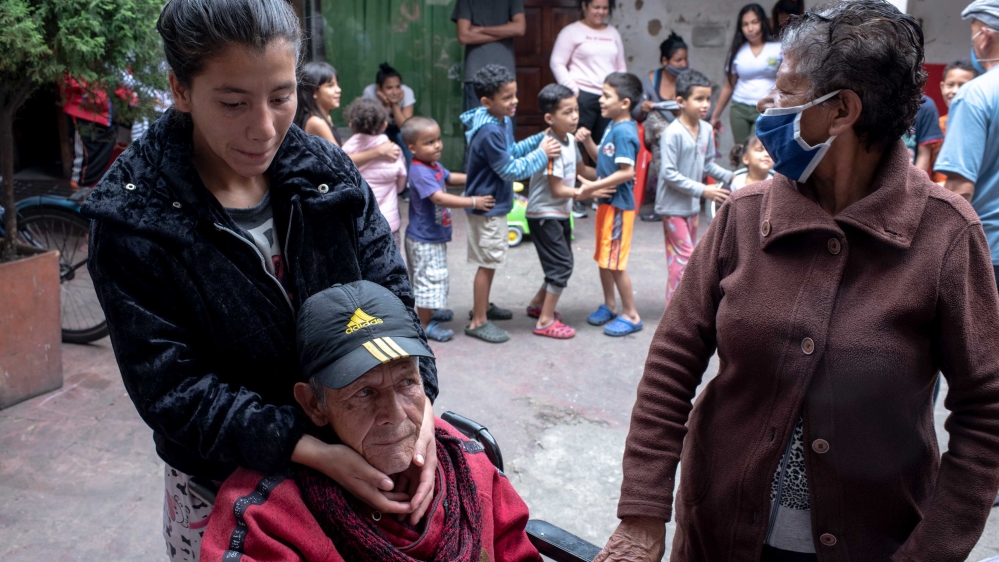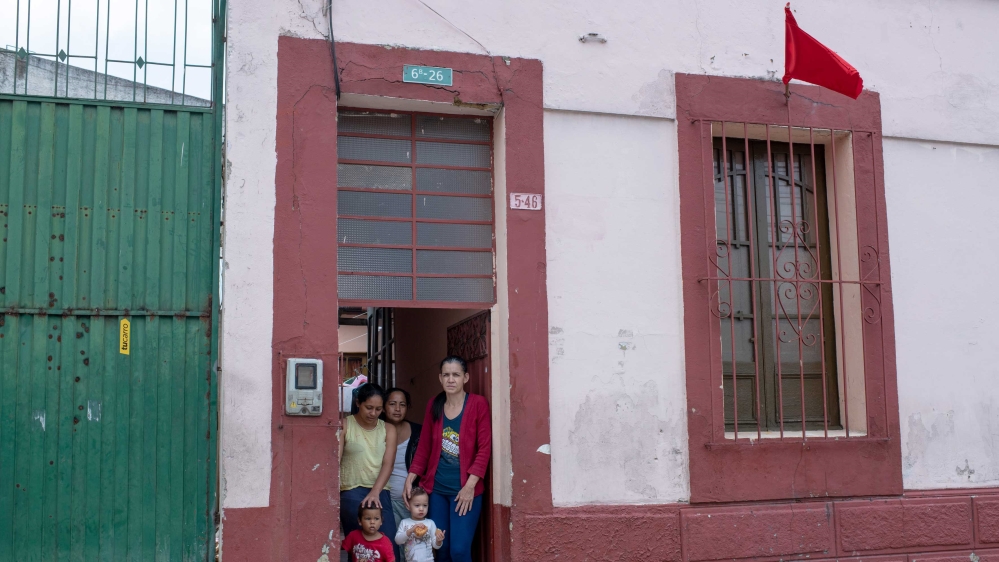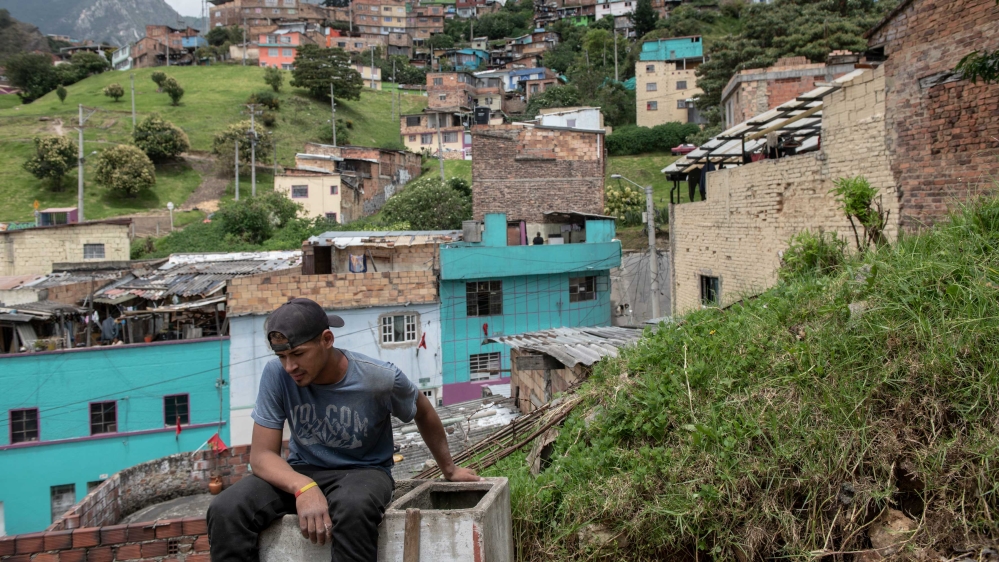An SOS: Colombians hang red rags for help amid COVID-19 lockdown
Red rags, T-shirts dot Colombia’s impoverished areas – a sign that many need food, help amid the coronavirus pandemic.

Bogota, Colombia – Hanging from Daniela Castano’s window is a red T-shirt draped on an old mop pole.
The piece of red cloth is one of many dotting the buildings of Bogota’s working-class neighbourhoods – a symbol of someone in need.
Keep reading
list of 3 itemsViolence against women up amid Latin America COVID-19 lockdowns
‘Nothing left’: Venezuelans head home amid coronavirus pandemic
Castano, 21, shares a small room in an old colonial building with her partner, Carlos, 22, and their two young children in Belen – a working-class neighbourhood in the centre of Bogota. Her 68-year-old grandmother and 73-year-old wheelchair-bound grandfather live next door. The family fled to the Colombian capital after being displaced from the violent northeastern town of Ituango in 2010, when Castano’s mother was killed by a rebel group during the country’s more than 50 years of conflict.
When Colombia’s coronavirus lockdown began, she lost her job as a waitress, and for the first time in her life had to beg on the streets.
“People treat you like dirt,” said Castano, looking gaunt and exhausted, adding that she received a fine from police for begging last week. “It’s shameful, but I’ve no other choice.”
Castano’s story is just one of many low-income and working-class Colombians and Venezuelan migrants living in the Andean nation, many of whom are unable to carry out their informal work due to the country’s strict coronavirus lockdown.

The government said that from April 7 onward, it would begin delivering subsidies of 160,000 Colombian Pesos ($40) on average per household, for three million families who are in situations of “poverty, extreme poverty and vulnerability”. Castano has yet to receive any help.
Colombia’s presidency said in a press release on Thursday that it will have given out one million cash transfers to vulnerable families as of next week.
Luis Alberto Rodriguez, head of the government’s National Planning Department, told Al Jazeera that delivering the subsidies to some communities is “a challenge” as many have never registered with the government before.
Of the more than a dozen Colombians Al Jazeera spoke to, only one had received any kind of government aid. For many, the red cloth that hangs outside their windows is a sign this help has yet to arrive.
“It’s an SOS. To show there’s no support, that people aren’t doing well,” said Jefferson Gonzales of a red T-shirt that hangs outside his home in the neighbourhood of Las Cruces, which sits adjacent to Belen. The 32-year-old mechanic, who is unable to work with a broken wrist, has yet to receive any help from the government. Some neighbours have helped him with food at times, but it’s not enough.
Red is for help, black for violence, blue for medical attention
The red rag phenomenon began a few weeks ago, in the impoverished peripheral neighbourhood of Soacha – on the outskirts of Bogota – where a large majority of the population work informally, without contracts or job security, and live day-to-day off their earnings.
The coronavirus lockdown, which began on March 24, brought their jobs to a dramatic halt as the government prohibited people from being on the streets to curb the spread of the virus, which has so far infected more than 5,000 people and killed at least 233. The lockdown was due to end on April 27, but President Ivan Duque extended it for two more weeks, causing further panic among the working classes.
Soacha’s mayor, Jose Carlos Saldarriaga, came up with the red cloth initiative.
“The red cloth is to show neighbours how one another is living, something that usually doesn’t happen. It allows a type of solidarity and support from their neighbours while facing the hunger they’re going through at the moment,” said Saldarriaga.
After he posted the idea on social media, those in need started to place red cloth outside their front doors, and the phenomenon spread to other parts of Bogota before gaining traction nationwide.

Saldarriaga said there are entire neighbourhoods in Soacha that have red rags on display.
Noelia Casas, 34, who is from Belen and manages the Casa B community centre, said the group has helped over 200 families who have arrived at the centre since the quarantine began. But their resources are limited.
“The need is getting worse every day. The line outside has been huge in recent days. We have people pleading for help,” said Casas, who over the past month says she often arrives home and breaks down. “It’s hard to say ‘no’ to some people, but we don’t have enough for everyone … there’s so much inequality in Colombia.”
People are not just in need of food and other supplies.
“A black cloth means that some kind of violence is being suffered in the home, blue is when medical help is needed and red is when they need food,” said John Orlando, Colombia Director for Action Against Hunger. “The needs are going to continue and most certainly increase in the coming weeks and months.”

While many have displayed red outside the windows, some say they have still not received any aid.
“We put it up 20 days ago – but nothing’s come of it,” said 35-year-old Leidy Olaya, who lives with her 57-year-old mother, Francy, in the impoverished Giradot neighbourhood.
“The situation has been hard. We live day to day,” said Francy Olaya, a cook, who showed off burn scars on her forearms as proof to her profession.
“The little bit of savings we had is gone. We have nothing and the government doesn’t understand.”